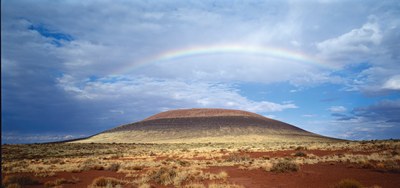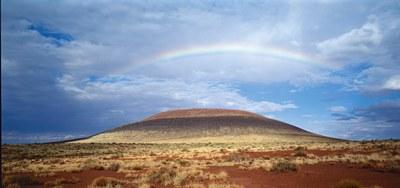The video below, part of James Turrell: A Retrospective, captures some of the experience of the artist’s work-in-progress: the transformation of an extinct volcano, Roden Crater, into a monumental work of art.
Erin Wright, Director of Artist Initiatives at LACMA, produced the short film. We talked to her about what it was like to visit Roden Crater.
Describe Roden Crater and its state of completion?
Roden Crater is not yet a finished project: it has several completed spaces, but Turrell’s vision is that it should eventually have twenty different spaces in which to view events in the sky. The hope is that enough funds can be raised to complete the lion’s share of project in the near future.
It’s an artwork that is, in essence, a naked eye observatory—built so that you have a way of seeing certain objects and events in the sky that would not otherwise be visible. So it was important to us to capture a solar event that happens during the winter solstice in December. Following that, we returned to interview the artist and capture footage of the parts of the project that have been built so far.
There’s a space called the Sun and Moon Chamber to observe celestial events—you can see images of the sun and moon on the surface of a large basalt stone called the “image stone.” Leading up from that stone is an approximately 900 foot tunnel that leads to a portal—an opening to the sky. The 900 foot tunnel acts as a giant refractor telescope and contains a very large lens at the center to focus the light.
A number of the spaces inside Roden Crater are Skyspaces where you can observe dawn and dusk; the color of the sky becomes incredibly vibrant as you’re watching it from inside the crater, because of the way Turrell has designed the Skyspace. If you walked outside, the color of the sky would be different. Turrell intends for the visitor to sit, from the onset of sunset until dark, to experience the full effect.
What is it like to try to capture the experience of Roden Crater?
It’s really, really difficult to film the spaces properly because they have such an awe-inspiring effect. With the Sun and Moon Chamber you have the celestial events happening in a very dark space with bright light passing, and it takes all the color out of the footage. When I first saw the footage I thought my cameraman had gone rogue and shot it in black and white. Because of the extreme light conditions: a very dark space with a very bright beam of light, it’s hard to detect any color. So it was important to capture shots of that space in a different situation when the lights were on, to convey the scale and beauty of the chamber.
 James Turrell, Roden Crater Project, view toward northeast, photo © Florian Holzherr
James Turrell, Roden Crater Project, view toward northeast, photo © Florian Holzherr
What isn't apparent in the film?
There’s something at the center of the crater’s bowl—an area that you see at the end of the film, called the Crater Plaza, and there are four large rectangular plinths that surround the crater eye. These are meant for people to lie down on and observe the sky and a phenomenon that is called celestial vaulting, where you can see the curve of the sky. You’re only able to see that because of the way Turrell has shaped the rim of the crater. He is manipulating your vision by allowing you to experience this phenomenon of seeing the sky as a dome rather than a flat plane.
Where will the film be shown?
We are showing it in the exhibition, and the Guggenheim is planning to screen the film during the summer as part of the programming related to their Turrell exhibition opening in late June.
Amy Heibel
Take part in our upcoming Turrell Trifecta Google Art Talk! Learn more and submit your question for curators of various James Turrell exhibitions at LACMA, Museum of Fine Arts, Houston, and the Guggenheim.



